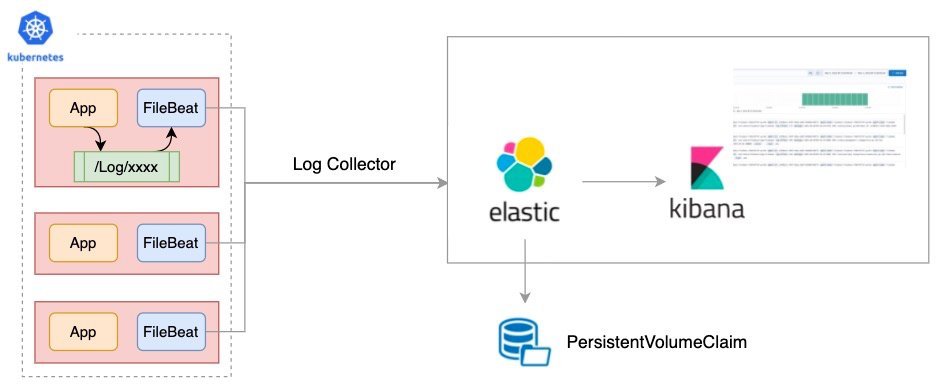As an indispensable part of any system, K8S Official Documentation also introduces various forms of log collection, summarizing the following three main types: Native approach, DaemonSet approach and Sidecar approach. All three approaches have advantages and disadvantages, and none of them can perfectly solve 100% of the problems, so they have to be fitted according to the scenarios.
The Sidecar approach deploys a separate logging agent for each POD, which is relatively more resource intensive, but more flexible and multi-tenant isolated, and is recommended for large K8S clusters or clusters serving multiple business parties as PAAS platforms.
EFK (ElasticSearch, FileBeat, Kibana) is a very popular and widely used log collection solution in the community, architecture as follows:

As shown above, the FileBeat container is deployed in Sidecar mode in the same Pod as the business app container, and the logs are collected and uploaded to ElasticSearch by means of a shared volume, configuration as follows:
spec:
containers:
- name: nginx
image: nginx:latest
volumeMounts:
# Share log directory with filebeat sidecar container via volumeMount
- mountPath: /var/log/nginx
name: log
- name: filebeat
image: docker.elastic.co/beats/filebeat:7.16.2
volumeMounts:
- mountPath: /var/log/nginx
name: log
volumes:
- name: log
emptyDir: {}Pod Sidecar Model: By defining specialized containers in Pods to perform the auxiliary work required by business containers (e.g. log collection, traffic proxy).
Advantage: decoupling the auxiliary capacity from the business container, realizing independent release and capacity reuse.
But there are also some disadvantages, as follows:
SidecarSet is an abstract concept for sidecar container management in OpenKruise, responsible for injecting and upgrading sidecar containers in k8s cluster, and is one of the core workloads of OpenKruise. For details, please refer to SidecarSet Document.
There is a lot of documentation in the community to install EFK, this article is mainly deployed by way of Helm, refer to Elastic Helm Charts. First of all, K8S cluster needs StorageClass for ElasticSearch PVC, this article uses the already created alibabacloud-cnfs-nas, as follows:
helm-charts% kubectl get storageclass
NAME PROVISIONER RECLAIMPOLICY VOLUMEBINDINGMODE ALLOWVOLUMEEXPANSION AGE
alibabacloud-cnfs-nas nasplugin.csi.alibabacloud.com Delete Immediate true 6d2hHelm deploy ElasticSearch, Kibana, as follows:
helm-charts% helm repo add elastic https://helm.elastic.co
helm-charts% helm repo update
## Install ElasticSearch,set storage-class is alibabacloud-cnfs-nas
helm-charts% helm install elasticsearch elastic/elasticsearch --version 7.16.3 --set persistence.annotations."volume.beta.kubernetes.io/storage-class"=alibabacloud-cnfs-nas -n elastic-system
## Install Kibana
helm-charts% helm install kibana elastic/kibana --version 7.16.3 --set service.type=LoadBalancer -n elastic-systemCreate FileBeat configuration (the ConfigMap be created under business namespace), as follows:
apiVersion: v1
data:
filebeat.yml: |
filebeat.inputs:
- type: log
paths:
- /var/log/*
output.elasticsearch:
host: '${NODE_NAME}'
hosts: '${ELASTICSEARCH_HOSTS:elasticsearch-master.elastic-system:9200}'
kind: ConfigMap
metadata:
name: filebeat-configFileBeat SidecarSet Configuration, as follows:
apiVersion: apps.kruise.io/v1alpha1
kind: SidecarSet
metadata:
name: filebeat-sidecarset
spec:
selector:
# Pod labels that need to be injected into the sidecar container
matchLabels:
kruise.io/inject-filebeat: "true"
# sidecarSet is effective for the whole cluster by default, you can specify the scope of the effect through the namespace field
#namespace: ns-xxx
containers:
- args:
- -e
- -E
- http.enabled=true
env:
- name: POD_NAMESPACE
valueFrom:
fieldRef:
apiVersion: v1
fieldPath: metadata.namespace
image: docker.elastic.co/beats/filebeat:7.16.2
livenessProbe:
exec:
command:
- sh
- -c
- |
#!/usr/bin/env bash -e
curl --fail 127.0.0.1:5066
name: filebeat
readinessProbe:
exec:
command:
- sh
- -c
- |
#!/usr/bin/env bash -e
filebeat test output
resources:
limits:
cpu: "1"
memory: 200Mi
requests:
cpu: 100m
memory: 100Mi
volumeMounts:
- mountPath: /usr/share/filebeat
name: filebeat-config
# Share log directory with app container via volumeMount
- mountPath: /var/log
name: log
volumes:
- configMap:
name: filebeat-config
name: filebeat-config
- name: log
emptyDir: {}For the scenario where machine resources are not sufficient, in order to reduce Pod resource requests, you can set sidecar container request.cpu=0. In this case, the Qos of Pod will be Burstable.
Nginx Deployment, only contains nginx container configuration, as follows:
apiVersion: apps/v1
kind: Deployment
metadata:
labels:
app: nginx
name: nginx
spec:
replicas: 1
selector:
matchLabels:
app: nginx
template:
metadata:
labels:
app: nginx
# need injection filebeat sidecar label
kruise.io/inject-filebeat: "true"
spec:
containers:
- name: nginx
image: nginx:latest
volumeMounts:
# Share log directory with filebeat sidecar container via volumeMount
- mountPath: /var/log/nginx
name: log
volumes:
- name: log
emptyDir: {}After applying the nginx deployment to the k8s cluster, it was found that the created Pods were injected with the filebeat sidecar container, as follows:
helm-charts% kubectl get pods nginx-5674976569-zdr7l -o yaml
status:
containerStatuses:
- containerID: containerd://5330c2b32262de83ed387e5a932f61acc52e3896ddfcb22d626c43d82638faf3
image: docker.elastic.co/beats/filebeat:7.16.2
name: filebeat
state:
running:
startedAt: "2022-03-02T12:17:15Z"
- containerID: containerd://1ad335f39c134f7a66a0370a275dd95f67f5fd3d3f1fe523c955408b14887229
image: docker.io/library/nginx:latest
name: nginx
state:
running:
startedAt: "2022-03-02T12:17:16Z"Below are two windows, and on the right is a client request to access the nginx service. At this point, after changing the image in filebeat sidecarSet from 7.16.2 to 7.16.3, we find that the Pod is not rebuilt. And the nginx service is not interrupted during the completion of filebeat sidecar container image upgrade 7.16.3 (the nginx service has only one Pod instance), as follows:

This feature relies on the ability of Kruise InPlace Update. However, upgrading sidecar independently comes with a risk, if the sidecar upgrade process fails, it will make Pod Not Ready and potentially affects the business, so SidecarSet itself provides rich progressive delivery capability to mitigate the risk. For more information, please refer to Kruise SidecarSet.
apiVersion: apps.kruise.io/v1alpha1
kind: SidecarSet
metadata:
name: sidecarset
spec:
# ...
updateStrategy:
type: RollingUpdate
# Maximum unavailable quantity
maxUnavailable: 20%
# Release in batches
partition: 90
# Canary release, via pod labels
selector:
matchLabels:
# Some Pods contain canary labels,
# or any other labels where a small number of pods can be selected
deploy-env: canaryIn addition, if it is similar to the ServiceMesh Envoy Mesh Container, you need to use the SidecarSet hot upgrade feature, please refer to SidecarSet HotUpgrade.
If you use Argo-cd to deploy Kruise SidecarSet, you need to configure Custom CRD Health Checks. According to this configuration, Argo-cd can implement SidecarSet Health Check, such as whether the SidecarSet is published or not, and whether the Pod ready, etc., as follows:
apiVersion: v1
kind: ConfigMap
metadata:
labels:
app.kubernetes.io/name: argocd-cm
app.kubernetes.io/part-of: argocd
name: argocd-cm
namespace: argocd
data:
resource.customizations.health.apps.kruise.io_SidecarSet: |
hs = {}
-- if paused
if obj.spec.updateStrategy.paused then
hs.status = "Suspended"
hs.message = "SidecarSet is Suspended"
return hs
end
-- check sidecarSet status
if obj.status ~= nil then
if obj.status.observedGeneration < obj.metadata.generation then
hs.status = "Progressing"
hs.message = "Waiting for rollout to finish: observed sidecarSet generation less then desired generation"
return hs
end
if obj.status.updatedPods < obj.spec.matchedPods then
hs.status = "Progressing"
hs.message = "Waiting for rollout to finish: replicas hasn't finished updating..."
return hs
end
if obj.status.updatedReadyPods < obj.status.updatedPods then
hs.status = "Progressing"
hs.message = "Waiting for rollout to finish: replicas hasn't finished updating..."
return hs
end
hs.status = "Healthy"
return hs
end
-- if status == nil
hs.status = "Progressing"
hs.message = "Waiting for sidecarSet"
return hsPod containing multiple containers will be more and more accepted by more and more developers, and thus the K8S ecosystem urgently needs a way to manage sidecar containers effectively. Kruise SidecarSet is an exploration of sidecar container management, and there are many companies in the community using Kruise SidecarSet to manage different types of sidecar containers.
While SidecarSet brings convenience, it also brings some management costs, such as: what if the Sidecar container is released at the same time with the business app container, and who owns the Pod when the containers in the Pod belong to multiple teams? Therefore, we also hope to explore with more developers in the community, and welcome everyone to provide some ideas to prosper the K8S ecology together.
Cloud-Native Devops Best Practices(2): GitOps + OpenKruise CloneSet
CloneSet lifecycle - Insert Customized Logic Into Pod Lifecycle

508 posts | 48 followers
FollowAlibaba Cloud Community - February 20, 2024
Alibaba Developer - March 31, 2020
Alibaba Developer - June 30, 2020
Xi Ning Wang - August 30, 2018
Alibaba Container Service - October 13, 2022
Alibaba Container Service - October 13, 2022

508 posts | 48 followers
Follow Best Practices
Best Practices
Follow our step-by-step best practices guides to build your own business case.
Learn More ACK One
ACK One
Provides a control plane to allow users to manage Kubernetes clusters that run based on different infrastructure resources
Learn More Container Service for Kubernetes
Container Service for Kubernetes
Alibaba Cloud Container Service for Kubernetes is a fully managed cloud container management service that supports native Kubernetes and integrates with other Alibaba Cloud products.
Learn More Container Registry
Container Registry
A secure image hosting platform providing containerized image lifecycle management
Learn MoreMore Posts by Alibaba Cloud Native Community